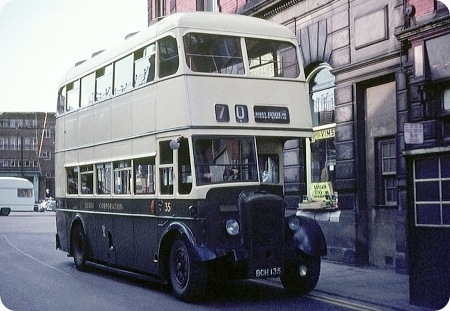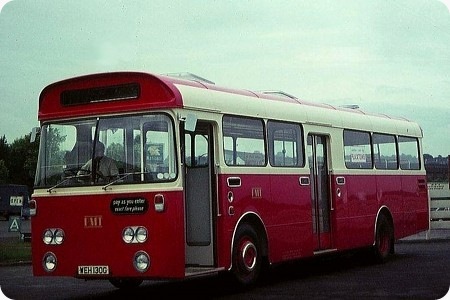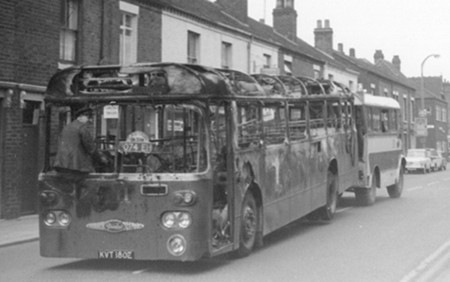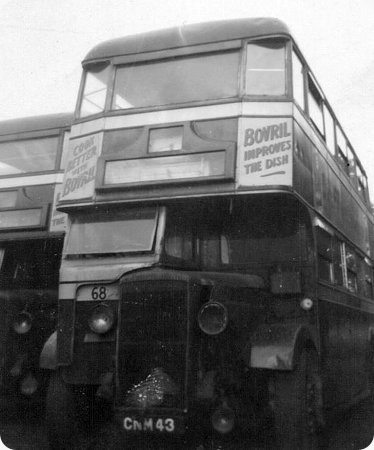
Copyright Ian Wild
Derby Corporation Transport
1949
Daimler CVD6
Brush H30/26R
I don’t know a great deal about Derby buses. This was taken on a short visit in August 1967. It’s a Daimler CVD6 with I think a Brush body. The olive green and cream livery was quite unusual and sombre and the provision of a polished rear bumper (just visible) seemed really old fashioned.
Photograph and Copy contributed by Ian Wild
A full list of Daimler codes can be seen here.
———
Brush were popular around their native Loughborough but "disappeared" after about 1952 when taken over by neighbour Willowbrook. They continued with their railway (locomotive) work and I believe they still exist (but not necessarily by the same name).
Derby and Nottingham were both big Brush customers but their biggest was possibly BET.
David Oldfield
———
This bus is identical to four vehicles purchased second hand by Samuel Ledgard and new to Exeter Corporation – these, too, had the useful but "dated" offside rear bumpers. Ledgard also bought the entire batch of ten similar buses withdrawn indecently early by Leeds City Transport. An immediate furore occurred in the Council Chamber and angry questions were asked as to why they had been sold and yet were in widespread use on busy services in and around Leeds – and just to rub salt in the wound they were to be seen daily passing their former home depot at Headingley!! At once a ban was placed on the sale of any further LCT vehicles for use within the City. The Brush bodies were beautifully built and were very heavy, but this posed no problems for the superb smooth and powerful Daimler engines.
Chris Youhill
———
Not sure they were taken over by Willowbrook David, more that they chose to leave the bus business, and sold their designs to neighbours Willowbrook. I live in Loughborough, and this is what local enthusiasts tell me, as well as the many retired folk who live here and worked at "The Brush".
Brush had a major national share of the bus body business, and were by no means a regional player though.
Brush do still exist in the town, much reduced, but more involved with transformer work and the like. At one time, they were the second biggest builder of tramcars in the UK. (Dick, Kerr being No1 with the ERTCW works at Preston).
The Derby style, also used by Exeter, Leeds Bradford et al is a composite development of the wartime design, whereas the post war metal bodies were much more rounded and stylish as seen on the Leicester Mk 111s.
John Whitaker
———
31/01/11
I’m very pleased to see this posted as I’ve been considering recently, the fact that Brush seemed to have several styles in production at the same time. There was the type shown, which as John says was a progression of the utility design, then the type supplied to Maidstone Corporation and Yorkshire Woollen which had metal window pans with more rounded corners. In addition, the Leicester Regent III’s (and also six for Ebor of Mansfield) again referred to by John, were a completely different design.
I’ve also wondered about their durability, as some were disposed of after relatively short lives, such as the Leeds examples which Chris refers to and the Bradford ones (although both had second lives with Ledgard and Green Bus) Nottingham only kept their Daimlers for nine years but the trolleybuses were built like tanks and would have lasted forever! Derby got over twenty years out of the batch shown, and I note Chris’s comment about them being beautifully built, so is there any truth in the suggestion that some operators had problems with Daimlers cooling system?
Derby had three batches of Daimlers, the ACH’s, the BCH’s (8ft wide) and the CRC’s of 1952 which were apparently finished by Willowbrook and had curved fronts, whilst the Crossleys and Fodens of the same year had the flat front as shown. Luckily a Daimler and a Crossley are still with us, if only a Foden could have made a trio!
Chris Barker
———
31/01/11
I stand to be corrected, but wasn’t this batch the first of the 8 foot wide version? The Leeds, Exeter, Bradford, SHMD, Nottingham and earlier Derby ones were 7 foot 6 wide – Derby No.27 (ACH627) is preserved. Derby had quite a large fleet of the 8 foot CVD6s with Brush bodywork. The obvious difference inside was that the light fittings were a polished flat circular plate, instead of the chromium plated "volcano" on the earlier vehicles. I have seen a comment in connection with SHMD that the "Brush bodies were rubbish". However, to me they always exuded charm. It is true that the Nottingham ones had a relatively short life, but then, Daimlers were little more than a footnote in a fleet that was massively dominated by AECs. By the way, for anyone straining to read it, the blind reads "Priory Estate via Sussex Circus". I never understood why they insisted on blanking off half the window and having such ridiculously small lettering!
Stephen Ford
———
31/01/11
Although not using a Brush design one of the biggest customers for Loughborough built bodywork was Midland Read who bought both pre and post war Brush bodywork The Falcon works of Brush were also responsible for many first generation diesel locos for British Rail most notably the class 47 also known in some circles as the Brush type 4
Chris Hough
———
31/01/11 – 15:00
Chris B mentions that it was said in certain quarters that the Daimler cooling system could give problems. I don’t know about this from the operators’ points of view, but I can say for certain that those splendid engines did run very hot all the time, Winter included, and "boiling" was not unknown. One unusual feature was that the exhaust manifold was on the inner (driver’s) side of the engine, which ensured a scorched left leg in Summer and welcome warmth in the colder times. The practice at Samuel Ledgard was to fit all second hand buses with those excellent "KL" underseat heaters – two downstairs and one under the front seat "up aloft." They certainly had the method off to perfection because all worked extremely effectively. I can relate without exaggeration that one Daimler in particular, former Exeter JFJ 55, was so hot in even the worst of weather that passengers were known on occasion to beg for the heaters to be turned OFF !!
Chris Youhill
———
31/01/11 – 20:16
Hence (presumably) the practice of driving them with the side access panel open & leaning on the mudguard: ah the smell of hot diesel… you just don’t get it today.
Joe
———
01/02/11 – 05:30
Indeed, I can just remember the Derby Daimlers operating with the bonnet side open, it was always a joy to see them running like that!
On the subject of Brush bodies, I had forgotten to mention the Ribble PD1’s and PD2’s which were yet another style, so when John W states that Brush sold their designs to Willowbrook when they left the bus business, it seems there were plenty of them!
Chris Barker
———
01/02/11 – 05:33
I have it on good authority that Birmingham’s Daimler engines were certainly plagued with overheating problems. Elsewhere smoking is the main problem I’ve heard of.
On the subject of Brush bodies it should not be forgotten that there were also 50 on Daimler CVG5 chassis for Manchester. According to "The Manchester Bus" by Eyre & Heaps these caused the company a major headache because they had not realised they had to be built to the Corporation’s own curvy design, but in the end they were among the finest bodies Brush ever built.
However, I first encountered the Brush name not on any of the products mentioned in these comments, but on an electric milk float!
Peter Williamson
———
02/02/11 – 06:18
Chris Y mentions about the exhaust manifold being on the driver’s side, and the smell of burning flesh from the driver in Summer! London Transport’s D’s were nearly all CWA6’s, but they did take about 10 CWD6’s to aid Daimler’s development of it. The non-standard engine, the exhaust heating and access problem and the fact the the timing chains were at the back of the engine, ensured that, in 1950, they were re-engined with surplus AEC engines. However, I well recall one CWD6 bearing a chalk comment in the driving cab "Dxxx, the fastest D of them all"!.
Incidentally, Chris Y talks about the ‘Sutton’ Daimler CWA’s going to Samuuel Ledgard, and I also thought there were no exceptions. However, I’ve found that SL took just one Merton one. It was Brush-bodied D126 (GYL 291), with them from 8/56 to 6/60. Does it ring a bell, Chris? (No pun intended!).
Chris Hebbron
———
02/02/11 – 10:04
I didn’t make things quite clear originally Chris and I actually meant that the twenty two 1946 Park Royal "HGF"s were all from Sutton Depot. I remember GYL 291 very well indeed and there is a super picture of it in "London’s Utility Buses" (page 127) by Ken Blacker. By coincidence it is passing Streatham Common within yards of the top of Leigham Court Road where my relations were and so its possible I may have ridden on it there as a youngster. Pictures of some of the twenty two "HGF"s also appear in the same splendid book. Ledgard also had just one more London utility Daimler – Duple bodied D178 (HGF 805). There is no doubt at all that these vehicles literally saved the Firm from going under due to death duties after Samuel Ledgard died in April 1952. Only those of us actually "on site" can appreciate the heroic heavy work that they did. Despite being second (or more) hand their performance and reliability were a credit to the maintenance in London and here in the West Riding of Yorkshire. Some of the schedules involved heavy loadings, tight timetables, hilly terrain and daily mileages in excess of two hundred and yet failures were virtually unheard of. "Lost mileage" was an obscene term at Ledgard’s, and any rare occurrence resulted in a thorough enquiry and, if necessary, the rolling of a guilty head or two !!
Chris Youhill
———
02/02/11 – 10:04
GYL 291 came to Sammy via Bee Line did it not Chris. So sayeth "Beer and Blue Buses", one of the best bus books I ever bought!
John Whitaker
———
02/02/11 – 20:53
GYL 291 certainly did arrive with Ledgard thus John. "Beer and Blue Buses" is indeed a splendid volume – marred only by the picture of a certain young conductor on the front cover – yours truly. I willingly helped my friend Don considerably with certain aspects of the book, notably operational issues and photo captions, and just a few of my own early pictures and my route map are included.
Chris Youhill
———
02/02/11 – 21:13
Thx, John, for clarifying its second owner, who obviously looked after it well.
Chris Y – bearing in mind the fragile nature of the bodies (and LT gave up overhauling them part-way through) did Ledgard’s not have body problems with them?
Chris Hebbron
———
03/02/11 – 10:40
Chris H – As GYL 291 was always at the Armley Head Depot and was our only Brush utility I can’t comment on it individually but I’m not aware of it being troublesome. As far as the utilities bought new by Ledgard are concerned the Roe and Duple bodies caused remarkably little trouble through out their existence. The same can’t be said for the two Pickering bodies on the Guys which fell into awful dilapidation long before they were replaced at eight years old !! Also, in contrast to the very satisfactory mechanical performance and reliability of the "Sutton HGFs", it has to be acknowledged that many of their Park Royal "relaxed utility" bodies needed a fair amount of rectification from time to time – this treatment though was invariably successful though and ensured further front line service. One exception was the very sad HGF 940 (D 263) of Otley Depot which was in such awful condition bodywise that, after only one recertification, it was the first of the twenty two to be withdrawn, and prematurely at that. The body of HGF 948 (D 271) was transferred on acquisition to one of Sammy’s own CWA6s, JUB 649 and made a very fine vehicle which was a pleasure to work on. The chassis of HGF 948 then received the rebuilt coach body from a 1935 Maudslay – Sammy’s were never afraid to tackle enterprising engineering exercises, but this strange scheme had everyone baffled and remains an enigma to this day !!
Chris Youhill
———
03/02/11 – 17:59
Re. Chris`s comments on HGF 948.
This was an amazing exercise which no enthusiast has ever really understood. How much service did the resultant coach actually enjoy, as I never saw it in service.
It is the sort of exercise which is more appropriate to the lifetime of Mr Ledgard, and not to the regime of the "executors" Ledgards just has to be the finest independent for enthusiasts to get excited about, and the book "Beer and Blue Buses" brings it all back to mind. Well worth the money, although a price rise is to be expected due to the sartorial elegance of a certain person on the front cover! Must be worth another fiver Chris!
John Whitaker
———
03/02/11 – 20:14
Is this book still available? If so how would I obtain a copy?
Chris Barker
———
04/02/11 – 06:50
John, regarding HGF 948 I’m happy to say that, despite its strange creation, it was extremely busy on all classes of work throughout its time with Ledgard. Arriving in April 1954 it ran until withdrawal after an accident in January 1960 and was sold in the April. Your kind remarks are greatly appreciated but I’m happy to say that there will be no increase in the price of the book as a result of my appearance on the cover – in fact many wags have been heard to loudly declare that a drastic reduction is called for !!
Chris B, the book is still available in many West Yorkshire book shops and, I believe, by mail order from the Samuel Ledgard Society or from the author, Don. Postage is expensive on account of the great weight of the book and so collection is preferable naturally. If you care ask Peter for my address and E Mail me, indicating your locality, I’ll see what arrangements can be made should you decide you’d like one.
Chris Youhill
———
05/02/11 – 05:35
Chris Y – Thank you for the detailed and interesting reply. I must say that I have warmed to SL following your various enthusiastic comments; a company, like Provincial, not afraid of ploughing its own furrow in a thoroughly professional way, especially through the hard times.
Now, how about a photo of that Maudslay/Daimler CWA6 conversion!
Chris Hebbron
———
05/02/11 – 05:45
Well, many thanks Chris for that, I do visit Leeds from time to time, so if there’s anywhere there which may have it, I’d be happy to seek it out on a future visit
Chris Barker
———
05/02/11 – 09:26
Thanks for the reference to "Beer and Blue Buses", John and Chris. I plan to go to the Dewsbury Bus Museum Open Day on March 13th. I wonder whether a stallholder there will have a few copies? Hope so!
Ian Thompson
———
27/02/11 – 20:42
I think what stands out on this body is the hallmarks it still bears with Brush’s austerity style, and these bodies were produced in 1949 and still identical to the style that Derby took in 1946 (22-27)! It doesn’t detract that they look handsome in Derby’s tasteful colour scheme.
Chris Hebbron
——— Top of this posting ———




